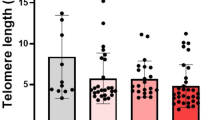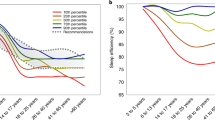Abstract
Background
Inadequate sleep duration has been suggested as a chronic stressor associated with changes in telomere length (TL). This study aimed to explore the association between sleep duration and TL using the INMA birth cohort study data.
Methods
A total of 1014 children were included in this study (cross-sectional: 686; longitudinal: 872). Sleep duration (h/day) was reported by caregivers at 4 years and classified into tertiles (7–10 h/day; >10–11 h/day; >11–14 h/day). Leucocyte TL at 4 and 7–9 years were measured using quantitative PCR methods. Multiple robust linear regression models, through log-level regression models, were used to report the % of difference among tertiles of sleep duration.
Results
In comparison to children who slept between >10 and 11 h/day, those in the highest category (more than 11 h/day) had 8.5% (95% CI: 3.56–13.6) longer telomeres at 4 years. Longitudinal analysis showed no significant association between sleep duration at 4 years and TL at 7–9 years.
Conclusion
Children who slept more hours per day had longer TL at 4 years independently of a wide range of confounder factors. Environmental conditions, such as sleep duration, might have a major impact on TL during the first years of life.
Impact
-
Telomere length was longer in children with longer sleep duration (>11 h/day) independently of a wide range of confounder factors at age 4 and remained consistent by sex.
-
Sleep routines are encouraged to promote positive child development, like the number of hours of sleep duration.
-
Considering the complex biology of telomere length, future studies still need to elucidate which biological pathways might explain the association between sleep duration and telomere length.
Similar content being viewed by others
Log in or create a free account to read this content
Gain free access to this article, as well as selected content from this journal and more on nature.com
or
Data availability
The data that support the findings of this study are not available for sharing due to ethical and legal restrictions implemented by the regional Ethical Committees and the Ethical Committee of the General Hospital of Alicante. As stated in the informed consent form from participants, we guaranteed the confidentiality of collected personal information from questionnaires and related data. Requests to access the data should be submitted to the corresponding author. Requests will be reviewed by the research team and will require a data transfer agreement.
References
Frank, M. G. & Heller, H. C. The function(s) of sleep. Handb. Exp. Pharm. 253, 3–34 (2019).
Mindell, J. A. & Williamson, A. A. Benefits of a bedtime routine in young children: sleep, development, and beyond. Sleep. Med. Rev. 40, 93–108 (2018).
Paruthi, S. et al. Recommended amount of sleep for pediatric populations: a consensus statement of the American Academy of Sleep Medicine. J. Clin. Sleep. Med. 12, 785–786 (2016).
Wheaton, A. G. & Claussen, A. H. Short sleep duration among infants, children, and adolescents aged 4 months-17 years – United States, 2016-2018. MMWR Morb. Mortal. Wkly Rep. 70, 1315–1321 (2021).
de Ruiter, I., Olmedo-Requena, R., Sánchez-Cruz, J. J. & Jiménez-Moleón, J. J. Changes in sleep duration in Spanish children aged 2–14 years from 1987 to 2011. Sleep. Med. 21, 145–150 (2016).
Carroll, J. E. et al. Insomnia and telomere length in older adults. Sleep 39, 559–564 (2016).
Huang, P. et al. The association between obstructive sleep apnea and shortened telomere length: a systematic review and meta-analysis. Sleep. Med. 48, 107–112 (2018).
Savolainen, K., Eriksson, J. G., Kajantie, E., Lahti, M. & Räikkönen, K. The history of sleep apnea is associated with shorter leukocyte telomere length: the Helsinki Birth Cohort Study. Sleep. Med. 15, 209–212 (2014).
Rentscher, K. E., Carroll, J. E. & Mitchell, C. Psychosocial stressors and telomere length: a current review of the science. Annu. Rev. Public Health 41, 223–245 (2020).
Deighton, S., Neville, A., Pusch, D. & Dobson, K. Biomarkers of adverse childhood experiences: a scoping review. Psychiatry Res. 269, 719–732 (2018).
Coimbra, B. M., Carvalho, C. M., Moretti, P. N., Mello, M. F. & Belangero, S. I. Stress-related telomere length in children: a systematic review. J. Psychiatr. Res. 92, 47–54 (2017).
James, S. et al. Sleep duration and telomere length in children. J. Pediatr. 187, 247–252.e1 (2017).
Nguyen, M. T. et al. Objectively measured sleep and telomere length in a population-based cohort of children and midlife adults. Sleep 43, zsz200 (2020).
Gorenjak, V., Petrelis, A. M., Stathopoulou, M. G. & Visvikis-Siest, S. Telomere length determinants in childhood. Clin. Chem. Lab Med. 58, 162–177 (2020).
Benetos, A. et al. Tracking and fixed ranking of leukocyte telomere length across the adult life course. Aging Cell 12, 615–621 (2013).
Guxens, M. et al. Cohort profile: the INMA–INfancia y Medio Ambiente–(Environment and Childhood) Project. Int J. Epidemiol. 41, 930–940 (2012).
Martens, D. S. et al. Newborn telomere length predicts later life telomere length: tracking telomere length from birth to child- and adulthood. eBioMedicine 63, 103164 (2021).
Martens, D. S. et al. Association of parental socioeconomic status and newborn telomere length. JAMA Netw. Open 3, e204057 (2020).
Notario-Barandiaran, L. et al. High adherence to a mediterranean diet at age 4 reduces overweight, obesity and abdominal obesity incidence in children at the age of 8. Int J. Obes. (Lond.) 44, 1906–1917 (2020).
Buckland, G. et al. Adherence to the Mediterranean diet and risk of coronary heart disease in the Spanish EPIC Cohort Study. Am. J. Epidemiol. 170, 1518–1529 (2009).
Higgins, J. P., Thompson, S. G., Deeks, J. J. & Altman, D. G. Measuring inconsistency in meta-analyses. BMJ 327, 557–560 (2003).
Mickey, R. M. & Greenland, S. The impact of confounder selection criteria on effect estimation. Am. J. Epidemiol. 129, 125–137 (1989).
Cribbet, M. R. et al. Cellular aging and restorative processes: subjective sleep quality and duration moderate the association between age and telomere length in a sample of middle-aged and older adults. Sleep 37, 65–70 (2014).
Redwine, L., Dang, J. & Irwin, M. Cellular adhesion molecule expression, nocturnal sleep, and partial night sleep deprivation. Brain Behav. Immun. 18, 333–340 (2004).
Prather, A. A. et al. Shorter leukocyte telomere length in midlife women with poor sleep quality. J. Aging Res. 2011, 721390 (2011).
Liang, G. et al. Associations between rotating night shifts, sleep duration, and telomere length in women. PLoS One 6, e23462 (2011).
Prather, A. A. et al. Tired telomeres: poor global sleep quality, perceived stress, and telomere length in immune cell subsets in obese men and women. Brain Behav. Immun. 47, 155–162 (2015).
Dutil, C. & Chaput, J. P. Inadequate sleep as a contributor to type 2 diabetes in children and adolescents. Nutr. Diabetes 7, e266 (2017).
Sluggett, L., Wagner, S. L. & Harris, R. L. Sleep duration and obesity in children and adolescents. Can. J. Diabetes 43, 146–152 (2019).
DelRosso, L. M., Mogavero, M. P. & Ferri, R. Effect of sleep disorders on blood pressure and hypertension in children. Curr. Hypertens. Rep. 22, 88 (2020).
Bathory, E. & Tomopoulos, S. Sleep regulation, physiology and development, sleep duration and patterns, and sleep hygiene in infants, toddlers, and preschool-age children. Curr. Probl. Pediatr. Adolesc. Health Care 47, 29–42 (2017).
Galland, B. C., Taylor, B. J., Elder, D. E. & Herbison, P. Normal sleep patterns in infants and children: a systematic review of observational studies. Sleep. Med. Rev. 16, 213–222 (2012).
Halal, C. S. & Nunes, M. L. Education in children’s sleep hygiene: which approaches are effective? A systematic review. J. Pediatr. (Rio J.) 90, 449–456 (2014).
Nettle, D. et al. Measurement of telomere length for longitudinal analysis: implications of assay precision. Am. J. Epidemiol. 190, 1406–1413 (2021).
Lai, T. P., Wright, W. E. & Shay, J. W. Comparison of telomere length measurement methods. Philos. Trans. R. Soc. Lond. B Biol. Sci. 373, 20160451 (2018).
Funding
This study was funded by Instituto de Salud Carlos III/Agencia Estatal de Investigación, grant number PI18/00825 Project: ‘Dieta y actividad física en embarazo y tras el nacimiento y longitud del telómero en niños y adolescentes: Proyecto TeloDiPA’ and Unión Europea (FEDER) ‘Una manera de hacer Europa’; Generalitat Valenciana (GVA/2021/191); D.S.M. holds a postdoctoral grant by the Flemish Scientific Fund (FWO grant 12X9620N). In Sabadell, this study was funded by grants from Instituto de Salud Carlos III (Red INMA G03/176; CB06/02/0041; PI041436; PI081151 incl. FEDER funds; PI12/01890 incl. FEDER funds; CP13/00054 incl. FEDER funds, PI15/00118 incl. FEDER funds, CPII18/00018), CIBERESP, Generalitat de Catalunya-CIRIT 1999SGR 00241, Generalitat de Catalunya-AGAUR (2009 SGR 501, 2014 SGR 822), Fundació La marató de TV3 (090430), Spanish Ministry of Economy and Competitiveness (SAF2012-32991 incl. FEDER funds), Agence Nationale de Securite Sanitaire de l’Alimentation de l’Environnement et du Travail (1262C0010), EU Commission (261357, 308333, 603794 and 634453). We acknowledge support from the Spanish Ministry of Science and Innovation and the State Research Agency through the ‘Centro de Excelencia Severo Ochoa 2019–2023’ Program (CEX2018-000806-S) and support from the Generalitat de Catalunya through the CERCA Program. In Asturias, this study was funded by ISCIII: PI04/2018, PI09/02311, PI13/02429, PI18/00909 co-funded by FEDER, ‘A way to make Europe’/‘Investing in your future’, Obra Social Cajastur/Fundación Liberbank and Universidad de Oviedo. In Valencia, this study was supported by grants from Instituto de Salud Carlos III [FIS-FEDER: 13/1944, 16/1288, 19/1338; Miguel Servet-FSE: MS15/0025, MSII20/0006 incl. FEDER funds], Generalitat Valenciana [AICO/2020/285] and Gobierno de España through Ministerio de Universidades under the grant CAS21/00008. The funders had no role in the design of the study; collection, management, analysis and interpretation of the data; preparation, review or approval and submission of the manuscript.
Author information
Authors and Affiliations
Contributions
F.P.-R., D.V.-G. and E.-M.N.-M. contributed to the conception and design of the study, advised on all statistical aspects and interpreted the data. F.P.-R. performed the literature search and the analyses. All authors critically reviewed this and previous drafts. All authors approved the final draft for submission, with final responsibility for publication. E.-M.N.-M. is the guarantor.
Corresponding author
Ethics declarations
Competing interests
The authors declare no competing interests.
Ethics approval and consent to participate
The regional Ethical Committees approved the INMA birth cohort study. This study complies with the Helsinki Declaration for human studies. All parents/legal tutors provided their written consent at each phase of the study.
Additional information
Publisher’s note Springer Nature remains neutral with regard to jurisdictional claims in published maps and institutional affiliations.
Supplementary information
Rights and permissions
Springer Nature or its licensor holds exclusive rights to this article under a publishing agreement with the author(s) or other rightsholder(s); author self-archiving of the accepted manuscript version of this article is solely governed by the terms of such publishing agreement and applicable law.
About this article
Cite this article
Petermann-Rocha, F., Valera-Gran, D., Fernández-Pires, P. et al. Children who sleep more may have longer telomeres: evidence from a longitudinal population study in Spain. Pediatr Res 93, 1419–1424 (2023). https://doi.org/10.1038/s41390-022-02255-w
Received:
Revised:
Accepted:
Published:
Issue date:
DOI: https://doi.org/10.1038/s41390-022-02255-w
This article is cited by
-
Association between telomere length and neuropsychological function at 4–5 years in children from the INMA project: a cross-sectional study
European Child & Adolescent Psychiatry (2024)



